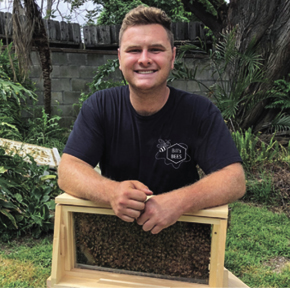From the Fields - Jeremy Jensen

By Jeremy Jensen, Los Angeles County beekeeper
We are rapidly approaching almond pollination. It’s the biggest time of year for beekeepers and a busy time for almond growers. Traditionally, all of the bees are placed into orchards by the second week in February. Right now, we’re grading hives. When we move into the orchard, we want all of the bees to grade at an average of about eight frames. We’re making sure everyone’s on track, and we’ve got lots of bees in the box.
For the first time in the collective memory, from the early reports, there’s an excess of bees on the market. The price of almonds is down. Almond growers are struggling to make a profit, and bees are one of their biggest costs. Beekeepers are looking to find pollination contracts. Some of the places that I’ve gone in the past are losing acreage, and they need fewer bees than they did last year. Us small guys, we’re clamoring to find a place for our hives.
As for as almond pollination, some of the fields that we go to are going to be flooded. We’ll see how it is getting into the fields and if we’re even able to do that depending on location. Along with the rain and bee yards and orchards being flooded, some of the passes are closed. We are curious about what it’s going to look like trying to get bees into the state and how this mass migration is going to work. There’s a lot in the air right now. It’s a nervous time for the industry.
A lot of us that don’t yet have a pollination contract are holding our breath to see where this shakes out. Are we going to get calls at the 11th hour from growers saying, “Our bee guy didn’t show up from Nebraska.”
We’re so thankful for the rain. It looks like we’re going to have a little bit of honey production on the coast this year, and that’s really exciting.




